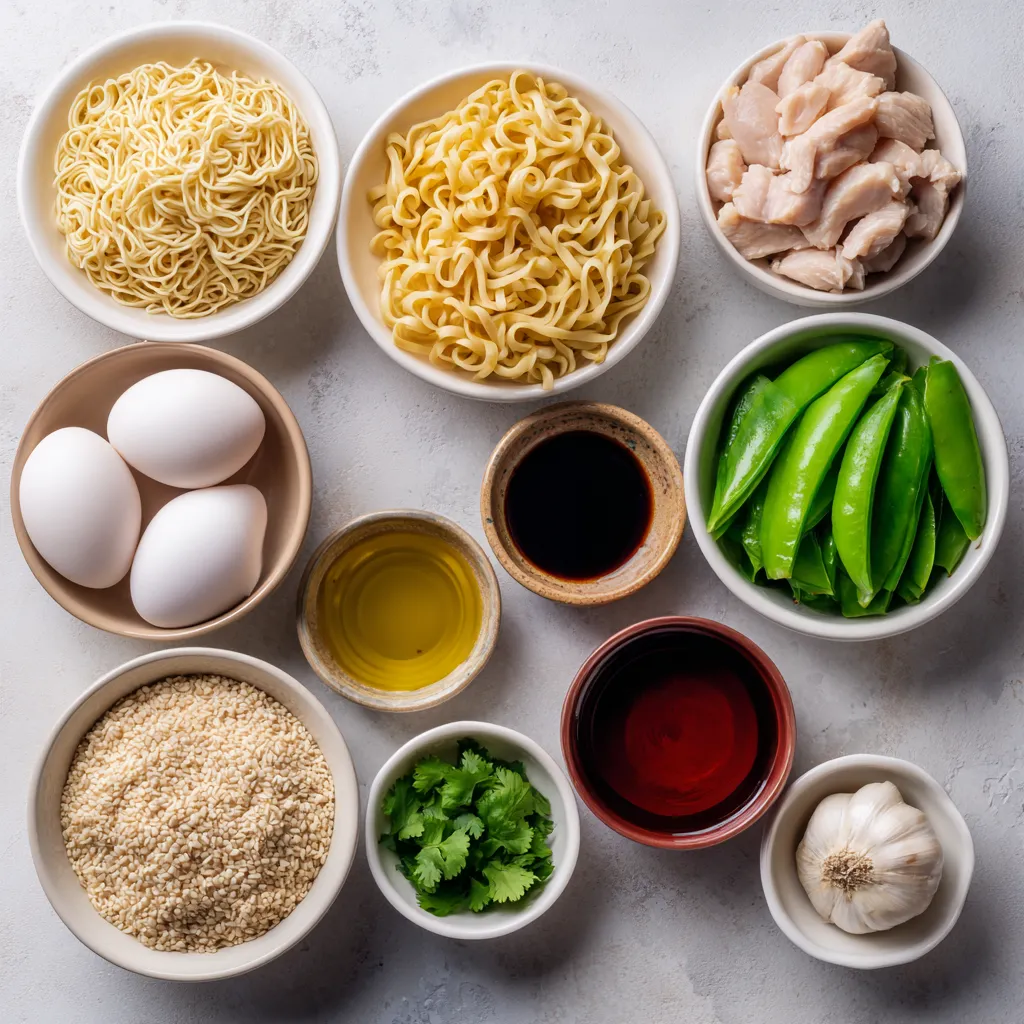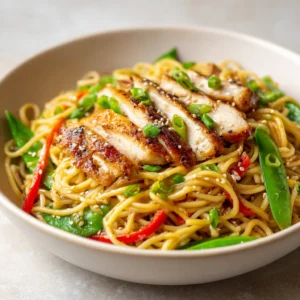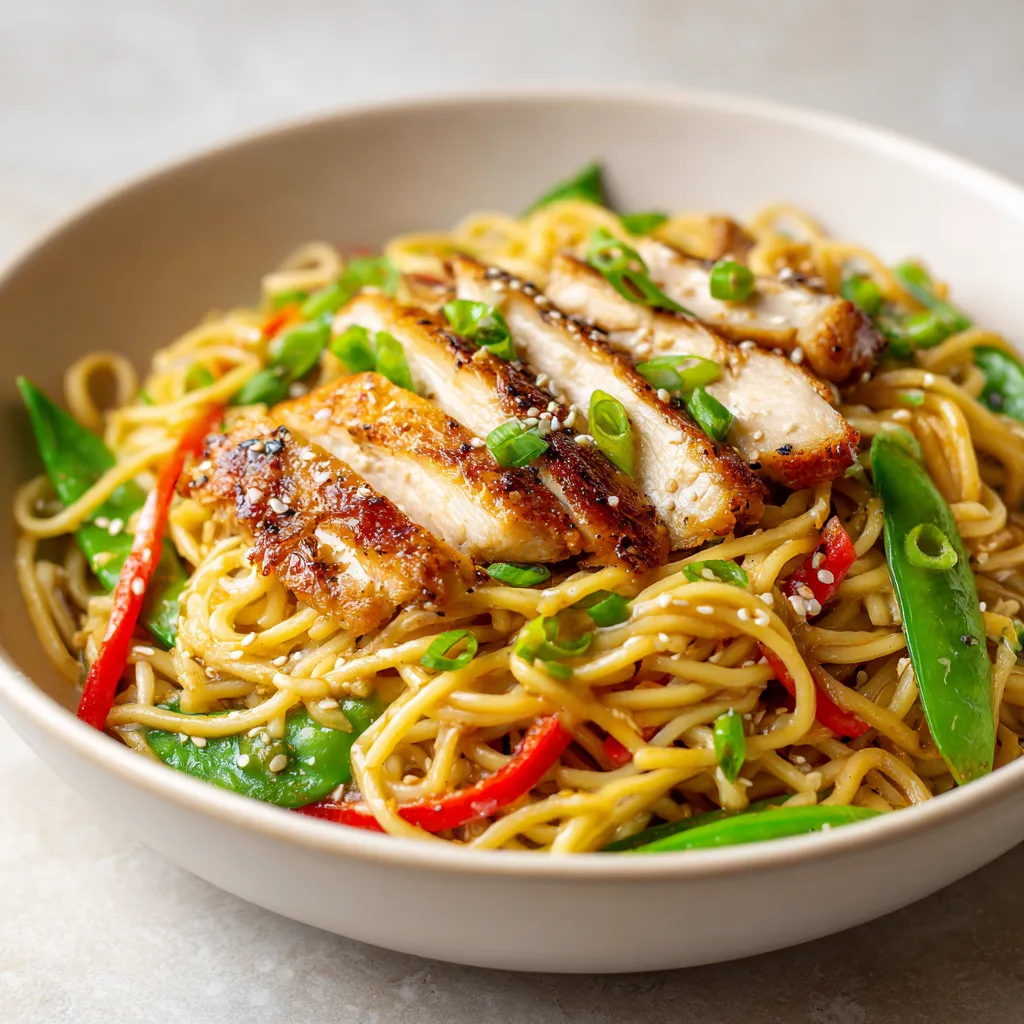Introduction
Miso Chicken Noodles offer a delightful and comforting meal that perfectly marries flavors from Japanese cuisine. This dish is not only a feast for the eyes with its vibrant colors but also a symphony of tastes that include the umami richness of miso, the spicy warmth of ginger, and the aromatic essence of garlic. Each bite is a reminder of cozy evenings at home or busy nights when a quick yet fulfilling dinner is in high demand.
What sets Miso Chicken Noodles apart is its versatility; you can effortlessly swap in seasonal vegetables or adjust the spice levels to suit your palette. With just a few ingredients, you’ll create a nutritious dish that’s bursting with flavor. The ease of preparation make it ideal for busy weeknights or even casual gatherings where you wish to impress your guests without spending hours in the kitchen.
Recipe Overview
– Total Time: 1 hour
– Servings: 4
– Difficulty: Not specified in the recipe
This dish makes for a perfect family meal or a delightful dish to share in a potluck or dinner party setting. The robust taste profile combined with fresh ingredients results in a healthy meal option that can easily satisfy different dietary preferences. The combination of chicken and vibrant vegetables not only adds vital nutrients to your plate but also a pleasing variety of textures.
Ingredients
– 400g (14 oz) boneless chicken thighs, thinly sliced
– 200g (7 oz) egg noodles or rice noodles
– 3 tablespoons white miso paste
– 2 tablespoons soy sauce
– 1 tablespoon pure sesame oil
– 1 tablespoon vegetable oil
– 2 cloves garlic, finely minced
– 1-inch piece fresh ginger, grated
– 2 cups low-sodium chicken broth
– 1 cup snap peas, trimmed
– 1 bell pepper, sliced (choose red or yellow for a vibrant look)
– 2 green onions, finely chopped
– 1 tablespoon toasted sesame seeds (for garnish)
– Fresh cilantro leaves (for garnish, optional)

Instructions
1. Marinate the Chicken: In a mixing bowl, combine the sliced chicken thighs with the white miso paste, soy sauce, and sesame oil. Stir thoroughly to ensure the chicken is well-coated. Allow the mixture to sit and marinate for at least 30 minutes, so the flavors can develop.
2. Cook the Noodles: In a large pot, bring salted water to a rolling boil. Add the egg noodles or rice noodles, and cook them according to the package instructions until they reach an al dente texture. Once cooked, drain the noodles well and set them aside.
3. Sauté Aromatics: In a large skillet or wok, heat the vegetable oil over medium-high heat. Add the minced garlic and grated ginger, sautéing them for about 1 minute until they become fragrant and flavorful.
4. Cook the Chicken: Carefully add the marinated chicken thighs to the skillet. Cook the chicken for approximately 5-7 minutes, stirring occasionally, until it is nicely browned and cooked through.
5. Add Vegetables: Pour in the chicken broth, then add the snap peas and sliced bell pepper into the skillet. Stir everything together and bring the mixture to a gentle simmer for about 3-4 minutes, just until the vegetables soften slightly while retaining their crunch.
6. Combine with Noodles: Add the cooked noodles to the skillet, tossing everything together to ensure that the noodles are thoroughly coated in the delicious miso sauce. Allow the mixture to cook for an additional 2-3 minutes to heat everything through properly.
7. Serve: Remove the skillet from the heat. Garnish your Miso Chicken Noodles with chopped green onions, toasted sesame seeds, and fresh cilantro leaves if desired. Serve piping hot and relish the rich, savory flavors!
Marinating the Chicken
Marinating the chicken is a crucial step that significantly enhances the flavor of your Miso Chicken Noodles. The marination process allows the ingredients to penetrate the meat, ensuring that the chicken is juicy and flavorful. For this particular recipe, you will combine the sliced boneless chicken thighs with white miso paste, soy sauce, and sesame oil. The white miso contributes a delicate sweetness and depth of flavor, while the soy sauce adds a salty, savory component. The sesame oil introduces nuttiness, tying together the taste profile beautifully.
For optimal results, it is recommended to allow the chicken to marinate for at least 30 minutes. If you have the time, marinating for a few hours or even overnight could yield even more robust flavors. If possible, use a resealable plastic bag for marinating, as it allows for even distribution of the marinade and makes for easy cleanup.
Cooking the Noodles
Preparing the noodles is a straightforward yet vital part of creating the perfect dish. To achieve the right texture, start by bringing a large pot of salted water to a rolling boil. This will ensure that your egg noodles or rice noodles cook evenly and absorb just the right amount of salt. Depending on the type of noodles you’re using, follow the package instructions closely to avoid overcooking.
Once the noodles have reached an al dente texture, it’s essential to drain them well. Allowing them to sit in water post-cooking can result in a gummy texture, which can detract from the overall experience of the dish. After draining, set the noodles aside; they will be combined with the chicken and vegetables later, so having them ready will make the final assembly seamless.
Sautéing Aromatics
Aromatics form the foundational flavors in many culinary traditions, and in the case of Miso Chicken Noodles, garlic and ginger are essential components. The importance of sautéing these ingredients in hot oil cannot be overstated. By cooking them briefly over medium-high heat, the natural essential oils are released, creating a fragrant base that enhances both the chicken and the overall dish.
Typically, you will sauté the minced garlic and grated ginger in vegetable oil for about 1 minute. This short cooking time helps to unlock their flavors without burning them, which can create a bitter taste that can spoil the delicate balance of flavors in your dish. The goal is to have the garlic and ginger become fragrant and lightly golden, setting the stage for the addition of the marinated chicken.
By carefully following these steps, you’ll be well on your way to crafting a comforting bowl of Miso Chicken Noodles that’s not only easy to prepare but also a delight to savor!
{{image_4}}
Sautéing Garlic and Ginger
Sautéing garlic and ginger effectively is crucial for ensuring maximum flavor extraction in your Miso Chicken Noodles. Begin by heating the vegetable oil over medium-high heat until it shimmers slightly. This indicates that the oil is hot enough to begin cooking the aromatics.
Add the minced garlic and grated ginger simultaneously to the hot oil. Stir continuously to avoid any burning. Garlic can turn bitter if cooked too long or at too high a temperature, while ginger should be just lightly browned to bring out its warmth and sweetness. Aim to sauté them for around 1 minute or until the garlic becomes golden and fragrant. The aroma will fill your kitchen, signaling that you’re on the right track.
Monitor the pan closely; if it becomes too hot and begins to smoke, lower the heat slightly. The goal is to gently coax out the robust flavors without compromising them with a burnt taste. If browning happens faster than you’d like, adding a splash of the chicken broth can help quickly cool the pan, allowing for more even cooking.
Cooking the Chicken
To cook your marinated chicken thighs effectively, make sure the skillet is preheated to a medium-high temperature before adding the chicken. This will help achieve a nice sear that locks in juices, creating a rich flavor. When placing the chicken into the skillet, avoid overcrowding to ensure even cooking; work in batches if necessary.
As the chicken cooks, it will take about 5-7 minutes to become golden brown and reach an internal temperature of 165°F (75°C). Stir occasionally—this not only promotes even browning but also helps incorporate the flavors from the garlic and ginger into the chicken. It’s essential to keep an eye on the chicken’s doneness, as overcooking can lead to dry, tough meat. When done, the chicken should be well-browned on the outside and tender throughout.
Adding Vegetables
Incorporating the snap peas and bell peppers requires careful timing to retain their crispness and vibrant color. After adding the chicken broth, immediately follow with the snap peas and sliced bell pepper. Stir well and bring the mixture to a gentle simmer. Allowing the vegetables to simmer for 3-4 minutes will soften them just enough while maintaining their crunch—a crucial textural element of this dish.
The chicken broth will provide a liquid base that will help in the cooking process, preventing the mixture from becoming too dry. If you find the sauce is too thick as it simmers, you can add a little extra broth to maintain an optimal consistency. The right balance ensures that every bite is saucy but not soupy.
Combining with Noodles
Integrating the cooked noodles into the chicken and vegetable mixture is critical for achieving full flavor absorption and ensuring an even coating. After draining the noodles, add them directly to the skillet with chicken and vegetables. Use tongs or two wooden spoons to toss everything together gently, ensuring the noodles are covered in the savory miso sauce.
This tossing technique allows for even distribution, making sure every bite is packed with flavor. Once combined, let the entire mixture cook for an additional 2-3 minutes. This step is not just for reheating; it allows the noodles to soak up some of the broth’s flavor, enhancing the overall taste of the dish.
Presentation Tips
To serve Miso Chicken Noodles, consider using shallow bowls that allow the vibrant colors of the dish to shine through. For a visually appealing dish, drizzle a small amount of extra sesame oil over the top just before serving. This adds sheen and a slightly nutty aroma that elevates the presentation.
Garnish with a generous sprinkle of toasted sesame seeds and finely chopped green onions. For an added burst of freshness, include a few cilantro leaves if you prefer. The various textures from the crunchy garnishes against the soft noodles and tender chicken create an inviting plate. Providing chopsticks alongside may enhance the dining experience, offering an authentic touch reminiscent of traditional Asian cuisine.
Flavor Profile
The flavor profile of Miso Chicken Noodles is characterized by the umami-rich miso and soy sauce that penetrate both the chicken and noodles. Miso paste adds a salty yet subtly sweet flavor that balances beautifully with the salty depth from the soy sauce.
The combination of textures is also paramount: the tender chicken thighs meld with the soft noodles, while the snap peas and bell peppers add crunch, creating a delightful contrast in each bite. Additionally, this dish is customizable—feel free to incorporate different vegetables like carrots or broccoli, or experiment with proteins such as shrimp or tofu to cater to various preferences.
Cooking Time Management
Efficiently managing your cooking times is vital for making Miso Chicken Noodles. With a prep time of around 30 minutes followed by approximately 30 minutes of cooking, this dish is manageable even on a busy weeknight. Start by marinating the chicken and preparing your ingredients such as chopping the vegetables and cooking the noodles.
To streamline the process, you can bring the water to a boil for the noodles while the chicken is marinating. This multitasking ensures that everything is ready to go, allowing you to maximize your time and serve the dish promptly. Remember that having everything prepped beforehand will yield the best results and make the cooking experience smoother.
Conclusion
Miso Chicken Noodles offers a delightful balance of tender marinated chicken, soft noodles, and vibrant, crunchy vegetables all wrapped in a rich, savory miso sauce. The preparation method is straightforward and manageable, making it suitable for any night of the week. The combination of flavors and textures creates an enticing dish sure to satisfy the palate.


